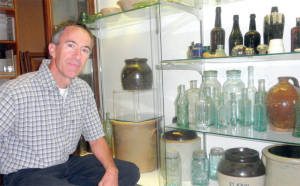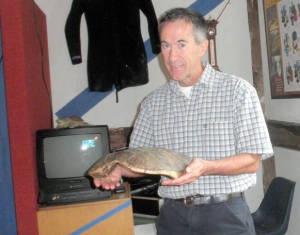Mr. Bottle’s world of glass: Grand opening of museum Saturday
By Gail Geraghty
Staff Writer

FINALLY, A SHOWROOM — Walter Bannon Jr. has finally realized his dream of a showroom for his vast collection of antique bottles, at the carriage house of the Robert Andrews estate owned by Peg Norman in South Bridgton. Here, he kneels beside one of the display cases he inherited when the Jones Museum in Sebago closed. Bannon also acquired other material from the museum, and hopes to carry on its tradition of showcasing rare glass and bottles. (Geraghty Photo)
When Walter Bannon of Sandy Creek goes bottle hunting, he looks for signs. Then he doesn’t hesitate; he digs. Or, more recently, he dives; he became a certified scuba diver three years ago, to better plumb the wealth of discarded bottles and artifacts in Greater Bridgton’s many lakes, ponds, rivers and streams.
The results, after more than a decade of collecting, speak for themselves — in lovely colors of violet, green red, yellow and blue — bottles of every conceivable hue. Glass-blowers created these works of art, a century or more ago. Their very DNA is preserved in bubbles inside the glass.
So this summer, when Peg Norman offered her carriage house in South Bridgton as a display space for his collection, and the Jones Museum in Sebago closed and offered its shelving and display cases, he saw both events as a sign.
“I’m the kind of person, when opportunity knocks, I jump on it,†said Bannon.
The Maine Antique Bottle & Glass Museum, next to Norman’s Margaret House across from Adams Pond, is the result. A grand opening will be held this Saturday, Oct. 8, beginning at 2 p.m. What makes the museum unique is that Bannon found nearly every bottle and artifact that is on display — and he can tell you where he found it, and the story behind it.
Bannon takes from the shelf a tiny clear bottle, still capped, with brown liquid still inside, from a section of the museum displaying quack cures. Embossed on the outside are the words “Dunn Brothers,†a local pharmacy that had the liquid “cures†made up for them. Another bottle is from Stevens Pharmacy. A third proclaims “Dr. Kilmer’s Swamp Root and Kidney Cure.â€
He found the first of them five or six years ago, walking through Sandy Creek, by the old railroad bed. “That really inspired me. Not only do I love history, I love the town of Bridgton, and here I have some old artifacts from the 1870s,†he said. “And that motivated me to get out digging again.â€
Bannon’s museum is a veritable treasure-trove of local history; along with the bottles, he has syrup jars, ink wells, salt shakers, vases, crocks, pitchers, glass insulators, wine bottles, pottery and bowls; and he has railroad stakes from the “Two-footers,†or Narrow Gauge Railroad that operated in town from the 1860s to the 1940s.
He even found in pieces, and reassembled, a little iron bank that looks a lot like the Oberg Insurance Co. building, once operated as a bank in town.
“Once you get bitten by this desire, this urge, it’s hard to shake it,†he said. “Especially when you know where to find things, and how to be successful.â€
He has a display case of bottles and glass items that are offered for sale. As for his museum collection, “If someone wants to purchase something, I might sell it. I only work part-time,†as a teacher in the local school system.
Over the years, Bannon has acquired quite a reputation locally for his successful bottle collecting and vast knowledge of the history of old glass and its value. He recalls that when a member of the Bridgton Historical Society, Lega Metcalf, first met him, she said, “Oh, you’re Mr. Bottle. She thought my last name was actually Mr. Bottle.â€
People often invite him to come search their homesteads for bottles. They say they’ve tried and tried to find the bottle dumps, without any luck. He’s been at it so long that all he has to do is take a quick look around, and he knows right where to go. The dumps are often in rock piles, or on the other side of stonewalls, where trash was thrown to keep it away from the house.
But when you’re digging, you’re on somebody’s land — and it’s not always possible, or practical, to obtain the needed permission, he said. “I knew I needed to get certified to dive, because I was sure there was stuff in the lakes and the rivers.â€
He was right. At the museum, an entire glass display case inherited from the Jones Museum is reserved for a large collection of what he calls his “underwater stuff,†the results of perhaps a dozen dives.
Many of the pieces are simply exquisite, like a pitcher found across the street, in Adams Pond in about 10 feet of water. “It’s still perfect, but was thrown away because maybe a restaurant closed,†he said. He also has several round-bottom “ballast†bottles, made in Belfast, Ireland; they provided ballast for ships.
A major focus of his museum is on education for children; Bannon plans to offer tours for area schoolchildren. He’s set up a railroad diorama, to show the likely locations for bottle dumps, and has an area where kids can cap old soda bottles; another explores the art of glass-blowing, and includes an original three-piece mold and glass blow rod.
“This will be the best and fastest hour a kid could have today,†he said. And the students will receive a certificate of learning after the tour.

WATCH OUT FOR SNAPPERS — When he started scuba diving for old bottles in lakes and rivers, Walter Bannon quickly realized he had to beware of snapping turtles after he mistakenly grabbed one by the tail. In the background at his Maine Antique Bottle & Glass Museum, Bannon displays his scuba diving equipment.
To demonstrate the experience of diving for artifacts, he has set up in one corner a 30-foot simulated dive tank equipped with a camera that the children can operate. Inside the tank, at various depths, are bottles and artifacts that can typically be found.
At the bottom of the tank is a little ceramic turtle. It’s a joke, meant to simulate the snapping turtles he’s encountered on his dives.
One time he was snorkeling in the Crooked River in Bolsters Mills, and pulled on something straight at the river bottom. He thought it was a stick.
“So I went down and pulled on it again, and this time it moved forward. And I looked, and I was pulling on the back of the tail of a snapping turtle.â€
Needless to say, he got out of the water fast — and “At this point, I don’t really reach out and grab everything I see.†He keeps a tool in his hand at all times, just in case.
“The rivers bury everything. One time I found a bottle with arched feet, just sitting on the bottom. So, you never know.â€
Bannon’s museum also has a library of nearly 200 books on bottle-collecting, some of which are offered for sale, including his own, Digger Down, published in 2005. There are pricing guides, and another area contains books from his personal collection and others he found while cleaning out the Jones Museum.
He said most of the Jones Museum collection of fine glass went to other museums when it closed this summer; but he was able to salvage some educational items, its sign, several rare glass plates and souvenir pieces.
Dorothy Lee Jones, the museum’s director and curator, and others associated with the museum are happy to have Bannon continuing their legacy in his own way, he said.
“Being unique to Maine, I think the draw will be pretty good, especially in the summer with so many campers looking for new and exciting things to experience,†said Bannon.
The museum will be opening on special evenings for guest presenters. It also hopes to host the Maine Antique Bottle Show next summer.
Saturday’s open house, from 2 to 4 p.m., will be at no charge. At other times, museum admission will be by donation. The Highland String Trio, of which he is a member, will provide musical entertainment. A friend will fill in for him, though; Bannon will be busy telling the stories behind his finds. He may be contacted for more information at 939-0205.

